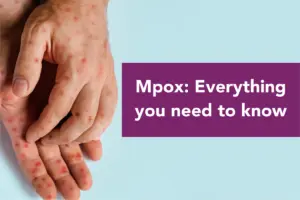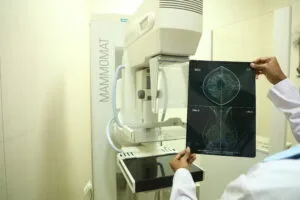Biomarkers In Lung Cancer: Overview

Lung cancer has shown a decrease in incidence and mortality in recent decades; however, it remains the most common cancer in males.
Despite advances in early detection and standard treatment, most patients are diagnosed at an advanced stage and have a poor prognosis.(1)
GENOMIC BIOMARKERS IN NSCLC
Advances in elucidating the molecular biology of lung cancer have led to the identification of a number of potential biomarkers that could be relevant in the clinical management of patients with non-small cell lung carcinoma (NSCLC).

Epidermal growth factor receptor (EGFR):
- Location: The epidermal growth factor receptor (EGFR) is a tyrosine kinase receptor member of the ERBB family. The EGFR gene is located on the short arm of chromosome 7 at position 1.(2)
- Prevalence in NSCLC: EGFR is overexpressed in 62% of NSCLCs, and its expression has been associated with poor prognosis.(3)
- Clinicopathologic features: EGFR mutations are found more often in adenocarcinomas with lepidic features from female never smokers.(4)
- Possible targeted therapies: The high response rates (55%-78%) to treatment with tyrosine kinase inhibitors (TKIs), such as gefitinib, erlotinib and afatinib, in patients with EGFR-mutant tumors, and the significantly greater progression-free survival (PFS) of these patients, have made EGFR TKIs the standard treatment for patients with these mutations.(5)
Anaplastic lymphoma kinase (ALK):
- Location: Anaplastic lymphoma kinase (ALK) is a tyrosine kinase receptor member of the insulin receptor superfamily. The ALK gene is located on the short arm of chromosome 2 at position 23.(6)
- Prevalence in NSCLC: The EML4-ALK fusion has been detected in 3.7% to 7% of NSCLCs.(7)
- Clinicopathologic features: Seen usually in adenocarcinomas with signet-ring cells or cribriform histology features, and is more common in young patients who have never smoked.(7)
- Possible targeted therapies: The ALK fusion defines a distinct subpopulation of patients with lung adenocarcinoma who are highly responsive (57%-74%) to ALK inhibitors such as crizotinib.(8)
Kirsten rat sarcoma viral oncogene homolog (KRAS):
- Location: KRAS is an oncogene located on the long arm of chromosome 12 at position 12.1.(9)
- Prevalence in NSCLC: KRAS mutations occur in 25% to 35% of patients with NSCLC.(10,11)
- Clinicopathologic features: Seen principally in adenocarcinomas with a solid pattern, and are found more often in white patients compared to Asians, in former or current smokers, but without sex predilection.(10,11)
- Possible targeted therapies: Although there are no targeted therapies approved for patients with lung cancer and KRAS mutation, several clinical trials aimed at downstream signaling targets are under way. Different phase 2 trials have reported improvements in both PFS and response rate with the combination of selumetinib (MEK1/MEK2 inhibitor) and docetaxel compared to docetaxel alone and promising results with sorafenib (RAS/RAF pathway inhibitor), with a disease control rate of approximately 50%.(12,13)
ROS proto-oncogene 1, receptor tyrosine kinase (ROS1):
- Location: ROS proto-oncogene 1, receptor tyrosine kinase (ROS1) is a tyrosine kinase receptor member of the insulin receptor family and is located on the long arm of chromosome 6 at position 22.(14)
- Prevalence in NSCLC: Approximately 1% to 2% of NSCLCs.(15)
- Clinicopathologic features: ROS1-rearranged NSCLC typically occurs in young, female, never smokers with a histologic diagnosis of adenocarcinoma.(14,15)
- Possible targeted therapies: Clinical trials have reported that patients with advanced NSCLC harboring ROS1 rearrangement have benefited from crizotinib treatment, showing response rates up to 80%.(14,16) Ongoing phase 1 and 2 studies are investigating the activity of crizotinib and ceritinib (ALK inhibitor) in ROS1-rearranged NSCLC.(14,16)
Human epidermal growth factor receptor 2 (HER2):
- Location: The human epidermal growth factor receptor 2 gene HER2 (ERBB2) is a proto-oncogene located on chromosome 17 at position 12.(17)
- Prevalence in NSCLC: Overexpression of HER2 has been reported in 7% to 34.9% of NSCLCs and has been associated with poor prognosis in patients with these tumors.(17) Activating mutations of HER2 have been found in 1.6% to 4% of lung cancers.(17,18)
- Clinicopathologic features: More often seen in adenocarcinomas in female, Asian, never or light smokers.(18)
- Possible targeted therapies: Different studies reinforce the importance of screening lung adenocarcinomas for HER2 mutation as a method to select patients who could benefit from HER2-targeted therapies (afatinib and trastuzumab), which have shown response rates of approximately 50%.(19)
RET proto-oncogene:
- Location: The RET proto-oncogene is located on the long arm of chromosome 10 at position 11.2.(20)
- Prevalence in NSCLC: Approximately 1% to 2% of NSCLCs harbor RET fusions, and several fusion partners, including kinesin family member 5B (KIF5B) (90%), coiled-coil domain containing 6 (CCDC6), nuclear receptor coactivator 4 (NCOA4), and tripartite motif-containing 33 (TRIM33), have been described.(21,22)
- Clinicopathologic features: RET-rearranged NSCLC typically occurs in adenocarcinomas with more poorly differentiated solid features in young never smokers, and it is mutually exclusive with known driver oncogenes.(21,23)
- Possible targeted therapies: In vitro studies showed that RET fusions lead to oncogenic transformation, which can be inhibited by multitargeted kinase inhibitors such as vandetanib, sorafenib, and sunitinib.(23)
MET proto-oncogene:
- Location: The MET gene is located on the long arm of chromosome 7 at position 31.(24)
- Prevalence in NSCLC & clinicopathologic features: In lung cancer, MET mutations are found in the extracellular semaphorin and juxtamembrane domains, occurring in 3% of squamous cell lung cancers and 8% of lung adenocarcinomas. MET amplifications are found in 4% of lung adenocarcinomas and 1% of squamous cell lung cancers and are associated with sensitivity to MET inhibitors.(25)
- Possible targeted therapies: MET inhibitors such as capmatinib and crizotinib (56).
B-RAF proto-oncogene, serine/threonine kinase (BRAF):
- Location: The B-RAF proto-oncogene, serine/threonine kinase (BRAF) oncogene is located on the long arm of chromosome 7 at position 34. (26)
- Prevalence in NSCLC: BRAF mutations have been reported in 1% to 3% of NSCLCs.(26)
- Clinicopathologic features: BRAF-mutated NSCLC has been reported to be mostly adenocarcinoma, and in contrast to patients with EGFR mutations or ALK rearrangements who are mostly never smokers, patients with BRAF mutations are mostly current or former smokers.(27)
- Possible targeted therapies: BRAF inhibitors, such as vemurafenib and dabrafenib, have high and selective activity against the V600E-mutant BRAF kinase, with overall responses rates from 33% to 42%.(28,29)
Phosphatidylinositol-4,5-bisphosphate 3-kinase catalytic subunit alpha (PIK3CA):
- Location: The PIK3CA gene is located on the long arm of chromosome 3 at position 26.3.(30)
- Prevalence in NSCLC: Mutations are found in 1% to 4% of patients with NSCLC, usually affecting exons 9 and 20 (80%).(31-35)
- Clinicopathologic features: PIK3CA mutations have not shown association with any clinicopathologic features (65, 68, 69).(32,34,35)
- Possible targeted therapies: Studies have shown that PIK3CA mutations in EGFR-mutated lung cancer confer resistance to EGFRTKIs and are a negative prognostic predictor in patients with NSCLC treated with EGFR-TKIs.(36)
Neurotrophic receptor tyrosine kinase 1 (NTRK1):
- Location: The neurotrophic receptor tyrosine kinase 1 (NTRK1) proto-oncogene is located on chromosome 1q21-22 and encodes for a receptor tyrosine kinase, also known as tropomyosin-related kinase (TRK) A.(1)
- Prevalence in NSCLC: In lung cancer, approximately 3% of adenocarcinomas harbor NTRK1 fusions (73).(37)
- Clinicopathologic features: Nil
- Possible targeted therapies: In early phase 1 studies, NTRK inhibitors, such as entrectinib and LOXO-101, have shown promising results in patients with solid tumors harboring NTRK fusions.(1)
Fibroblast growth factor receptor (FGFR):
- Location: The fibroblast growth factor receptor (FGFR) gene is located on chromosome 8 at position 12 and encodes for a tyrosine kinase receptor belonging to the FGFR family.(1)
- Prevalence in NSCLC & clinicopathologic features: Somatic FGFR mutations in lung tumors usually occur in FGFR2 and FGFR3 and have been detected in 6% of lung squamous cell carcinomas.(38) In lung cancer, the incidence of FGFR1 amplification is significantly higher in squamous cell carcinoma (20%) compared to adenocarcinoma (3%) and is more frequent in current smokers compared to former and never smokers.(1)
- Possible targeted therapies: Multiple FGFR inhibitors, such as ponatinib, a multitargeted kinase inhibitor that displays potent pan-anti-FGFR activity, are in development, with promising results in cell lines and xenograft models.(39)
Discoidin domain receptor tyrosine kinase 2 (DDR2):
- Location: The discoidin domain receptor tyrosine kinase 2 gene (DDR2) is located on the long arm of chromosome 1 at position 23.3 and encodes for a tyrosine kinase receptor that is expressed in mesenchymal tissues and which binds fibrillar collagen as ligand.(40)
- Prevalence in NSCLC & clinicopathologic features: In lung cancer, DDR2 mutations occur in 3% to 4% of lung squamous cell carcinomas compared to 0.5% of adenocarcinomas and are only present in smokers.(1)
- Possible targeted therapies: DDR2 mutations have been associated with response to dasatinib (a multitargeted kinase inhibitor) in preclinical models.(1)
IMMUNOTHERAPY MARKERS IN LUNG CANCER
Historically, lung cancer has not been considered very immunogenic because of several failed attempts with cytokines and vaccines. Nevertheless, over the past few years, immunotherapy has re-emerged strongly with the development of checkpoint inhibitors as treatments for NSCLC.
Cytotoxic T-lymphocyte-associated antigen 4 (CTLA-4)
Monoclonal antibodies that inhibit CTLA-4, such as ipilimumab, are available to prevent the binding of CTLA-4 with its ligands (CD80/CD86), leading to reactivation of the antitumor immune response mediated by specific T cells.(1)
Programmed death-ligand 1 receptor (PD-1)
Several monoclonal antibodies targeting the interaction between PD-1 and its ligands PD-L1 and PD-L2 are available. Clinical trials in NSCLC have shown sustained responses in approximately 20% of unselected patients to treatment with monoclonal antibodies against PD-1, such as nivolumab and pembrolizumab, and with antibodies against PD-L1 such as MPDL3280A. The FDA has approved the use of nivolumab in advanced NSCLC on or after platinum-based chemotherapy and pembrolizumab as second-line treatment for NSCLC after chemotherapy.(41,42)
Furthermore, IHC PD-L1 positivity in NSCLC has been identified as a potential predictor of response to anti- PD-1 and anti-PD-L1 monoclonal antibody therapy and also as a prognostic biomarker.(1)
REFERENCES
- Villalobos P, Wistuba II. Lung Cancer Biomarkers. Hematol Oncol Clin North Am. 2017 Feb;31(1):13-29.
- Khalil FK, Altiok S. Advances in EGFR as a Predictive Marker in Lung Adenocarcinoma. Cancer Control J Moffitt Cancer Cent. 2015 Apr;22(2):193-9.
- Sharma SV, Bell DW, Settleman J, Haber DA. Epidermal growth factor receptor mutations in lung cancer. Nat Rev Cancer. 2007 Mar;7(3):169-81.
- Sholl LM. Biomarkers in lung adenocarcinoma: a decade of progress. Arch Pathol Lab Med. 2015 Apr;139(4):469-80.
- Mok TSK. Personalized medicine in lung cancer: what we need to know. Nat Rev Clin Oncol. 2011 Aug 23;8(11):661-8.
- Zhao Z, Verma V, Zhang M. Anaplastic lymphoma kinase: Role in cancer and therapy perspective. Cancer Biol Ther. 2015;16(12):1691-701.
- Chatziandreou I, Tsioli P, Sakellariou S, Mourkioti I, Giannopoulou I, Levidou G, et al. Comprehensive Molecular Analysis of NSCLC; Clinicopathological Associations. PloS One. 2015;10(7):e0133859.
- Solomon BJ, Mok T, Kim D-W, Wu Y-L, Nakagawa K, Mekhail T, et al. First-line crizotinib versus chemotherapy in ALK-positive lung cancer. N Engl J Med. 2014 Dec 4;371(23):2167-77.
- McBride OW, Swan DC, Tronick SR, Gol R, Klimanis D, Moore DE, et al. Regional chromosomal localization of N-ras, K-ras-1, K-ras-2 and myb oncogenes in human cells. Nucleic Acids Res. 1983 Dec 10;11(23):8221-36.
- Dogan S, Shen R, Ang DC, Johnson ML, D’Angelo SP, Paik PK, et al. Molecular epidemiology of EGFR and KRAS mutations in 3,026 lung adenocarcinomas: higher susceptibility of women to smoking-related KRAS-mutant cancers. Clin Cancer Res Off J Am Assoc Cancer Res. 2012 Nov 15;18(22):6169-77.
- Kempf E, Rousseau B, Besse B, Paz-Ares L. KRAS oncogene in lung cancer: focus on molecularly driven clinical trials. Eur Respir Rev Off J Eur Respir Soc. 2016 Mar;25(139):71-6.
- Dingemans A-MC, Mellema WW, Groen HJM, van Wijk A, Burgers SA, Kunst PWA, et al. A phase II study of sorafenib in patients with platinum-pretreated, advanced (Stage IIIb or IV) non-small cell lung cancer with a KRAS mutation. Clin Cancer Res Off J Am Assoc Cancer Res. 2013 Feb 1;19(3):743-51.
- Jänne PA, Shaw AT, Pereira JR, Jeannin G, Vansteenkiste J, Barrios C, et al. Selumetinib plus docetaxel for KRAS-mutant advanced non-small-cell lung cancer: a randomised, multicentre, placebo-controlled, phase 2 study. Lancet Oncol. 2013 Jan;14(1):38-47.
- Bergethon K, Shaw AT, Ou S-HI, Katayama R, Lovly CM, McDonald NT, et al. ROS1 rearrangements define a unique molecular class of lung cancers. J Clin Oncol Off J Am Soc Clin Oncol. 2012 Mar 10;30(8):863-70.
- Yoshida A, Kohno T, Tsuta K, Wakai S, Arai Y, Shimada Y, et al. ROS1-rearranged lung cancer: a clinicopathologic and molecular study of 15 surgical cases. Am J Surg Pathol. 2013 Apr;37(4):554-62.
- Mazières J, Zalcman G, Crinò L, Biondani P, Barlesi F, Filleron T, et al. Crizotinib therapy for advanced lung adenocarcinoma and a ROS1 rearrangement: results from the EUROS1 cohort. J Clin Oncol Off J Am Soc Clin Oncol. 2015 Mar 20;33(9):992-9.
- Ricciardi GRR, Russo A, Franchina T, Ferraro G, Zanghì M, Picone A, et al. NSCLC and HER2: between lights and shadows. J Thorac Oncol Off Publ Int Assoc Study Lung Cancer. 2014 Dec;9(12):1750-62.
- Shigematsu H, Takahashi T, Nomura M, Majmudar K, Suzuki M, Lee H, et al. Somatic mutations of the HER2 kinase domain in lung adenocarcinomas. Cancer Res. 2005 Mar 1;65(5):1642-6.
- Mazières J, Peters S, Lepage B, Cortot AB, Barlesi F, Beau-Faller M, et al. Lung cancer that harbors an HER2 mutation: epidemiologic characteristics and therapeutic perspectives. J Clin Oncol Off J Am Soc Clin Oncol. 2013 Jun 1;31(16):1997-2003.
- Knowles PP, Murray-Rust J, Kjaer S, Scott RP, Hanrahan S, Santoro M, et al. Structure and chemical inhibition of the RET tyrosine kinase domain. J Biol Chem. 2006 Nov 3;281(44):33577-87.
- Wang R, Hu H, Pan Y, Li Y, Ye T, Li C, et al. RET fusions define a unique molecular and clinicopathologic subtype of non-small-cell lung cancer. J Clin Oncol Off J Am Soc Clin Oncol. 2012 Dec 10;30(35):4352-9.
- Drilon A, Wang L, Hasanovic A, Suehara Y, Lipson D, Stephens P, et al. Response to Cabozantinib in patients with RET fusion-positive lung adenocarcinomas. Cancer Discov. 2013 Jun;3(6):630-5.
- Lipson D, Capelletti M, Yelensky R, Otto G, Parker A, Jarosz M, et al. Identification of new ALK and RET gene fusions from colorectal and lung cancer biopsies. Nat Med. 2012 Feb 12;18(3):382-4.
- Zhen Z, Giordano S, Longati P, Medico E, Campiglio M, Comoglio PM. Structural and functional domains critical for constitutive activation of the HGF-receptor (Met). Oncogene. 1994 Jun;9(6):1691-7.
- Paik PK, Drilon A, Fan P-D, Yu H, Rekhtman N, Ginsberg MS, et al. Response to MET inhibitors in patients with stage IV lung adenocarcinomas harboring MET mutations causing exon 14 skipping. Cancer Discov. 2015 Aug;5(8):842-9.
- Cardarella S, Ogino A, Nishino M, Butaney M, Shen J, Lydon C, et al. Clinical, pathologic, and biologic features associated with BRAF mutations in non-small cell lung cancer. Clin Cancer Res Off J Am Assoc Cancer Res. 2013 Aug 15;19(16):4532-40.
- Paik PK, Arcila ME, Fara M, Sima CS, Miller VA, Kris MG, et al. Clinical characteristics of patients with lung adenocarcinomas harboring BRAF mutations. J Clin Oncol Off J Am Soc Clin Oncol. 2011 May 20;29(15):2046-51.
- Planchard D, Kim TM, Mazieres J, Quoix E, Riely G, Barlesi F, et al. Dabrafenib in patients with BRAFV600E-positive advanced non-small-cell lung cancer: a single-arm, multicentre, open-label, phase 2 trial. Lancet Oncol. 2016 May;17(5):642-50.
- Hyman DM, Puzanov I, Subbiah V, Faris JE, Chau I, Blay J-Y, et al. Vemurafenib in Multiple Nonmelanoma Cancers with BRAF V600 Mutations. N Engl J Med. 2015 Aug 20;373(8):726-36.
- Karakas B, Bachman KE, Park BH. Mutation of the PIK3CA oncogene in human cancers. Br J Cancer. 2006 Feb 27;94(4):455-9.
- Fujimoto J, Wistuba II. Current concepts on the molecular pathology of non-small cell lung carcinoma. Semin Diagn Pathol. 2014 Jul;31(4):306-13.
- Yamamoto H, Shigematsu H, Nomura M, Lockwood WW, Sato M, Okumura N, et al. PIK3CA mutations and copy number gains in human lung cancers. Cancer Res. 2008 Sep 1;68(17):6913-21.
- Samuels Y, Velculescu VE. Oncogenic mutations of PIK3CA in human cancers. Cell Cycle Georget Tex. 2004 Oct;3(10):1221-4.
- Endoh H, Yatabe Y, Kosaka T, Kuwano H, Mitsudomi T. PTEN and PIK3CA expression is associated with prolonged survival after gefitinib treatment in EGFR-mutated lung cancer patients. J Thorac Oncol Off Publ Int Assoc Study Lung Cancer. 2006 Sep;1(7):629-34.
- Kawano O, Sasaki H, Endo K, Suzuki E, Haneda H, Yukiue H, et al. PIK3CA mutation status in Japanese lung cancer patients. Lung Cancer Amst Neth. 2006 Nov;54(2):209-15.
- Chen J-Y, Cheng Y-N, Han L, Wei F, Yu W-W, Zhang X-W, et al. Predictive value of K-ras and PIK3CA in non-small cell lung cancer patients treated with EGFR-TKIs: a systemic review and meta-analysis. Cancer Biol Med. 2015 Jun;12(2):126-39.
- Vaishnavi A, Capelletti M, Le AT, Kako S, Butaney M, Ercan D, et al. Oncogenic and drug-sensitive NTRK1 rearrangements in lung cancer. Nat Med. 2013 Nov;19(11):1469-72.
- Liao RG, Jung J, Tchaicha J, Wilkerson MD, Sivachenko A, Beauchamp EM, et al. Inhibitor-sensitive FGFR2 and FGFR3 mutations in lung squamous cell carcinoma. Cancer Res. 2013 Aug 15;73(16):5195-205.
- Gozgit JM, Wong MJ, Moran L, Wardwell S, Mohemmad QK, Narasimhan NI, et al. Ponatinib (AP24534), a multitargeted pan-FGFR inhibitor with activity in multiple FGFR-amplified or mutated cancer models. Mol Cancer Ther. 2012 Mar;11(3):690-9.
- Payne LS, Huang PH. Discoidin domain receptor 2 signaling networks and therapy in lung cancer. J Thorac Oncol Off Publ Int Assoc Study Lung Cancer. 2014 Jun;9(6):900-4.
- Garon EB, Rizvi NA, Hui R, Leighl N, Balmanoukian AS, Eder JP, et al. Pembrolizumab for the treatment of non-small-cell lung cancer. N Engl J Med. 2015 May 21;372(21):2018-28.
- Gettinger SN, Horn L, Gandhi L, Spigel DR, Antonia SJ, Rizvi NA, et al. Overall Survival and Long-Term Safety of Nivolumab (Anti-Programmed Death 1 Antibody, BMS-936558, ONO-4538) in Patients With Previously Treated Advanced Non-Small-Cell Lung Cancer. J Clin Oncol Off J Am Soc Clin Oncol. 2015 Jun 20;33(18):2004-12.



